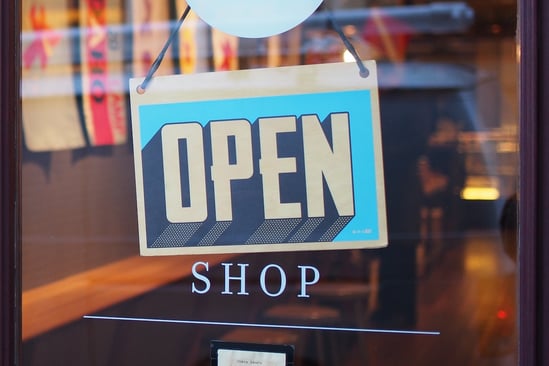How Brand Manufacturers Can Prepare for a Post-COVID-19 World
Written By: Salsify
The “new normal” we all currently find ourselves in is only temporary. At some point in the (hopefully) near future, our lives will return to some semblance of the “old normal.” However, it is also indisputable that our jobs as brand manufacturers will be forever changed because of what is happening during this crisis.
Online shopping has grown the equivalent of five years within a couple of months. Inventory management and product-content activation have had to be more agile and customer-centric during this period of rapid change.
Brands that focused on winning on Amazon now find themselves entwined in a bottle-necked supply chain. Media investments that used to perform reliably, such as events and sports sponsorships, are now irrelevant.
While navigating through these changes can feel like living through a year’s worth of disruption every week, it’s important to ask: How do we take what is happening right now and best apply it to our digital shelf after initiatives after this crisis has passed? How can we successfully prepare for a post-COVID-19 world?
Although not all of the above shifts will be long-lasting, this crisis represents a time-sensitive, long-term opportunity for brands to accelerate their capabilities in four mission-critical areas.
1. Increase Omnichannel Capabilities
When the world does return to “normal,” digital interactions and purchasing will be part of the new way of life. “In times of unease, consumers may be clamoring for certainty and guaranteed supply, directly from the makers of their preferred brand. Many [direct-to-consumer (D2C)] manufacturers are also mastering their service via quick, personalized responses to questions and providing empathy for consumers’ needs and concerns,” Nielsen stressed in mid-March.
We may not expect the rate of adoption to stay as high it currently is for D2C marketplaces, social commerce, and ecommerce-enabled mid-market, local retailers. But we can say for certain that it will not return to pre-COVID-19 levels.
Brands that can take advantage of the increased willingness of consumers to find them in new or alternate channels will expand their ability to build more profitable and personal omnichannel journeys in the future.
2. Ensure Flexible Inventory and Multiple Routes to Market
Brands have now learned that over-reliance on one channel or route-to-market may endanger their business when said channels become clogged with demand and face significant supply and fulfillment issues.
Being less reliant on one single channel means not only paving the way for consumers to acquire their product across multiple channels, but it also means more control over supply, inventory, and allocation.
3. Lean Into Experience
COVID-19 has some categories scrambling to capture their fair share of this increased demand, and other less-in-demand categories searching for better frameworks to create long-lasting consumer relationships.
Many of our customers believe that consumers that shop both in-store and online are far more valuable than those who solely shop either in-store or online. For current high-demand categories, ecommerce ideas that were put on the back burner are now back into play. Brands also have the opportunity to establish new additive online behaviors.
For brands that are in categories that are currently deemed “nonessential” by both retailers and consumers, the opportunity becomes leaning into relationships and loyalty-building to sustain brand engagement until purchasing resumes.
For brands in these categories, success during this time means building a healthy brand-forward and relationship-driven digital ecosystem that becomes a healthy complement to offline and online sales when they regain momentum.
4. Create More Content, Fresher Content — Better Content
Many brands have been in the habit of creating content playbooks that build and house content months ahead of its usage date. The current crisis has forced brands to throw out their existing content playbooks and create new ones in a matter of days. Throughout this process, the traditional manner of making and acquiring content may be challenged.
Gary Vaynerchuk, CEO of media and communications company VanyerMedia, expects the rise of scrappier, more agile, content development to lower the cost of creative at scale ultimately. This shift would also increase brand expectations for fresh, relevant content and drive down the cost of this increasingly impactful work.
We have seen many brands equip staff with mini studio setups that allow them to do their own photography. We have also heard of increased use of user-generated content (UGC), as this content tends to feel more authentic for consumers. These consumers recently also have more time on their hands to get creative with how they represent their favorite brands.
Aligned with Vaynerchuk’s projections, we expect that brands are bound to interrogate creative costs and sustain the practice of creating more with less.
Emerge Better, Stronger, and More Agile
There has been a lot of buzz about “pent up demand,” which is the prediction that consumers will finally make delayed purchases after this crisis has ended, including booking vacations, buying luxury goods, and making significant investments. Some brands predict a dramatic increase in sales for these categories.
For now, the best that brands can do is make sure they are using this opportunity to create long-overdue adjustments to increase agility, efficiency, and digital modes of fulfillment. The hope is to emerge better, stronger, and more agile when this is all over.
Written by: Salsify
Salsify helps thousands of brand manufacturers, distributors, and retailers in over 140 countries collaborate to win on the digital shelf.
Recent Posts
Curated Commerce: How Shopping Apps Can Boost Sales
The State of Secondhand Shopping: Circular Commerce Trends and Consumer Insights
How To Kick Shopping Cart Abandonment to the Curb
Subscribe to the Below the Fold Newsletter
Standing out on the digital shelf starts with access to the latest industry content. Subscribe to Below the Fold, our monthly content newsletter, and join other commerce leaders.

.svg)